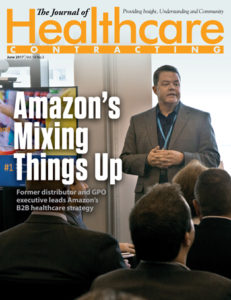Former distributor and GPO executive leads Amazon’s B2B healthcare strategy
 Start with the customer and work backward. That’s how Amazon has approached the numerous industries it now serves. It seems to work, as the company has become the seller of many consumer categories, and provider of two-hour delivery for tens of thousands of different items. It has allowed Amazon to roll out a fleet of branded planes, test a drone delivery system, and stream television series and movies.
Start with the customer and work backward. That’s how Amazon has approached the numerous industries it now serves. It seems to work, as the company has become the seller of many consumer categories, and provider of two-hour delivery for tens of thousands of different items. It has allowed Amazon to roll out a fleet of branded planes, test a drone delivery system, and stream television series and movies.
Now Amazon is leveraging this strategy in the B2B space, including the healthcare supply chain as a vertical under Amazon Business.
“If you use Amazon as a consumer, you’re probably familiar with a lot of the things that we’ve done to make that experience easy,” says Chris Holt, leader of global healthcare, Amazon Business. “You find an item and click it. We already have your address, your credit card and your delivery preferences, and it’s on its way.
“We’re taking the same kind of approach with Amazon Business, where we’re reviewing anything that a business does today and finding a way to make it faster, smoother, simpler, easier.”
Amazon Business generated more than a billion dollars in sales its first year. To handle particularly complex industries, the company launched three business verticals last year – Education, Government and Healthcare. Since August 2016, Holt has led the healthcare segment.
Already hundreds of thousands of medical products are available on Amazon Business. In addition, “We have built out things like licensing capabilities, so a doctor’s office, a surgery center or a hospital can open an Amazon Business account, identify themselves as a healthcare practitioner, and submit their license for verification,” he says. “After we verify their license, we enable what we call business-only selection.” Amazon Business can also accommodate GPO-negotiated pricing and payment by invoice.
Holt comes well-prepared for the job. Before joining Amazon, he served as senior vice president, business ventures, for Vizient (formerly VHA). Prior to that, he worked for distributors Tiger Medical Group as well as Cardinal Health, and he served as vice president, global healthcare, for UPS Inc.
“All of those roles were important preparation for what we’re doing here at Amazon,” he says. “I think the opportunity for me was to be able to understand how each of these major players work – how they make money, how they bring products to market, and how they drive innovation for customers.”
Preparing for millennials
 Holt believes Amazon can help those in the healthcare supply chain modernize some of their processes, while accommodating its complexity.
Holt believes Amazon can help those in the healthcare supply chain modernize some of their processes, while accommodating its complexity.
“If you look at the way a hospital system or a medical device or supply company cuts purchase orders, identifies suppliers, shops for products, or negotiates terms and conditions, much of that has been constrained by what their information systems can do. I think that has really boxed in the way that companies function.”
Modern business – and the millennials coming into the workplace – can’t operate in the old way.
Millennials are used to going to Amazon and quickly finding anything they need – even the most obscure items, he says. “A real example is somebody who wants to find peanut butter that is gluten-free, non-GMO, organic, crunchy, in a certain size. And they want to find it in three to five clicks. That’s the mentality of millennial buyers at home – and they want to be able to do the same things at work.
“The shift from offline traditional methods to online purchasing is very significant,” he continues. “It is our belief that the online channel is going to be the primary marketplace for even the most premium of medical devices in the future. That trend is already proven by data. So we’ve created a dedicated team within Amazon Business to enable medical product suppliers to be visible and participate in that channel.”
 While accommodating the wants and needs of tomorrow’s workforce, Amazon Business has worked to address some of the peculiarities of business purchasing. For example, business customers can pay by invoice, something that is foreign to the consumer side of Amazon’s operation. They can view and purchase items at the GPO- or IDN-negotiated price. That too is something new for Amazon, which has always preferred a dynamic pricing model, says Holt.
While accommodating the wants and needs of tomorrow’s workforce, Amazon Business has worked to address some of the peculiarities of business purchasing. For example, business customers can pay by invoice, something that is foreign to the consumer side of Amazon’s operation. They can view and purchase items at the GPO- or IDN-negotiated price. That too is something new for Amazon, which has always preferred a dynamic pricing model, says Holt.
“When our [healthcare] customers and suppliers told us, ‘We really need to see our negotiated pricing,’ we made it work. But we caution them to be careful not to simply replicate the old model, but to think about a new model and how it could be better.” Long-term contracts may provide stability, consistency and comfort, but they also create economic inefficiencies in the market, he believes.
Future supply chain
Holt believes that Amazon Business can help the entire healthcare supply chain evolve from its current “push” model to a more sophisticated “pull” model.
A push supply chain is one in which manufacturers push newly made products into the market, in hopes that customers will buy them, and that inventory will be in the right place at the right time, he says. Excessive inventory leads to higher sales costs and, potentially, obsolescence. On the other hand, insufficient inventory leads to customer dissatisfaction and, potentially, sub-optimal patient care.
“With a ‘pull’ supply chain, you address a lot of these issues,” says Holt. “You create a demand signal at the point of consumption, and you engineer all the ordering and replenishment backward from that.
“There’s no silver bullet solution, but if we can shift to a pull model, everybody in the channel wins. There’s a great opportunity there.”
“We’re trying to think about what would make the model function more effectively,” he continues. “In no way do we look at any particular stakeholder as the target we’re trying to disrupt. Instead, we think the root of the problem is this: There are a bunch of silos, and the sharing of information, flow of dollars and flow of products across those silos is choppy.
“So I like to say that the enemy is waste and inefficiency. That’s what we compete against. Unlocking [the supply chain] means helping to eliminate that waste and inefficiency.”
Dogs, doors, desks: Working at Amazon
Amazon is changing the world in many interesting ways, says Chris Holt, leader of global healthcare, Amazon Business. And those changes begin at the company’s headquarters in Seattle, Wash.
“I have to confess, I had to adjust working at Amazon,” says Holt, who worked for Vizient prior to joining Amazon. “This morning, when I came into my office, the dog from down the hall was in here waiting for me, eager to see if I had anything for her to eat.
“It’s just part of our culture here. We think this creates a friendlier place, a place where people can be comfortable. And when people are more comfortable, they can do their best work.” A relaxed dress code helps as well.
Another Amazon quirk: Every employee’s desk resembles a converted door. That’s because company founder Jeff Bezos used such a desk when he started his company out of his garage in the mid-90s. “It reminds us of frugality, which is one of our leadership principles,” says Holt.
But maybe the best part of working for Amazon is its energy and creativity. “Seattle is full of bright Amazonians working on different fascinating projects. As you go from building to building and talk to people, you find out what different folks are working on and the different ways they are trying to change the world.
“My colleagues are working on things totally unrelated to healthcare, business-to-business trade or supply chain. I tell them what I’m doing, and they have no idea what I’m talking about. But that’s exciting. That’s fun.”

